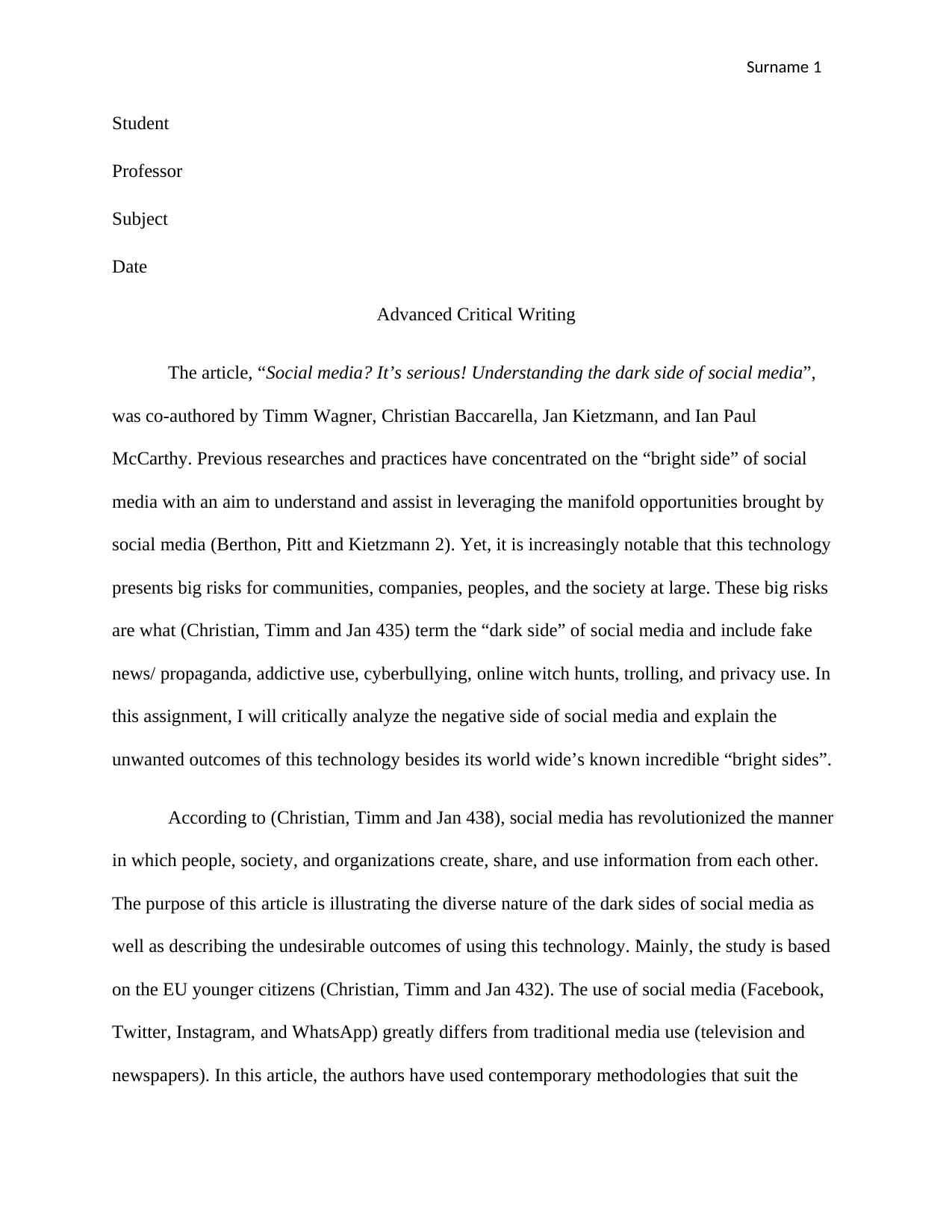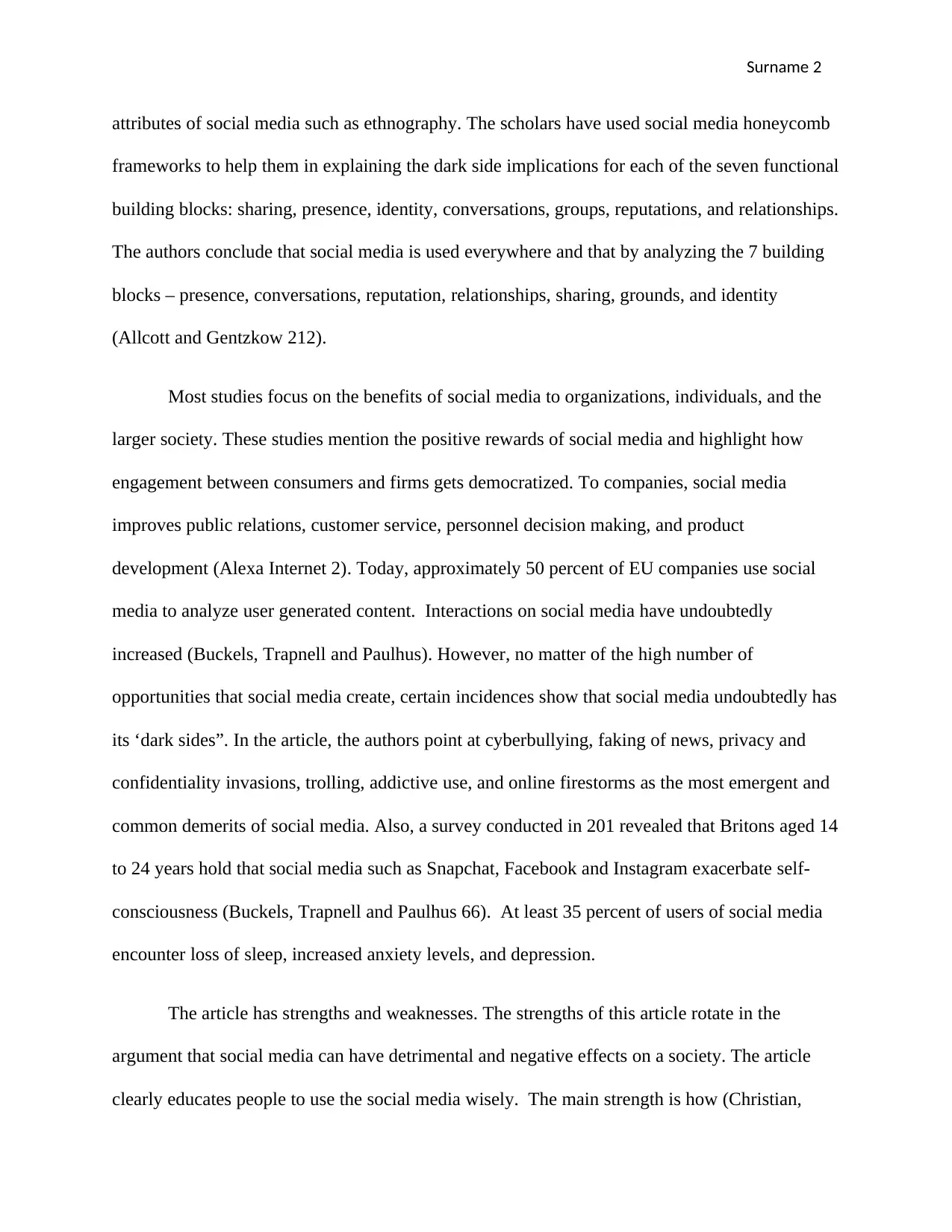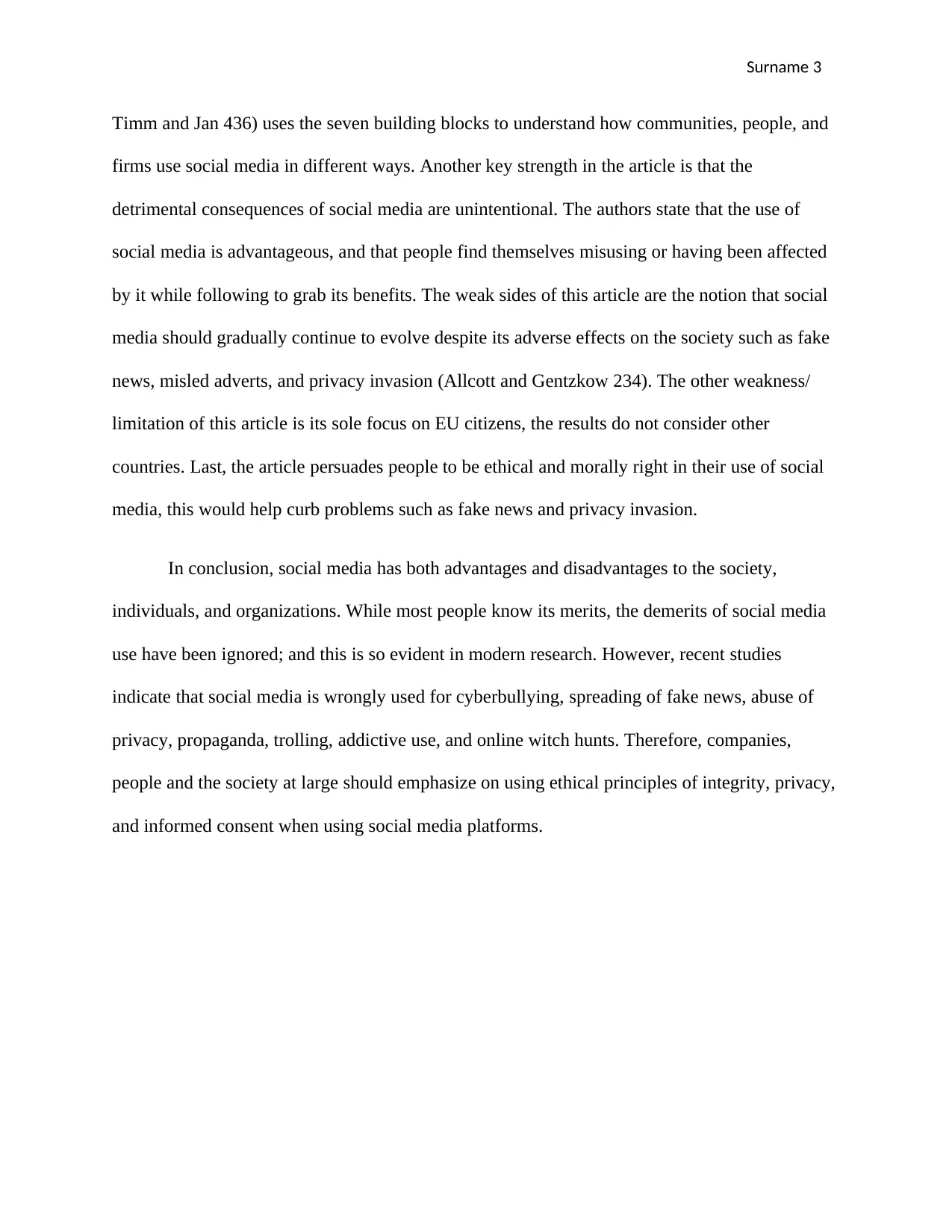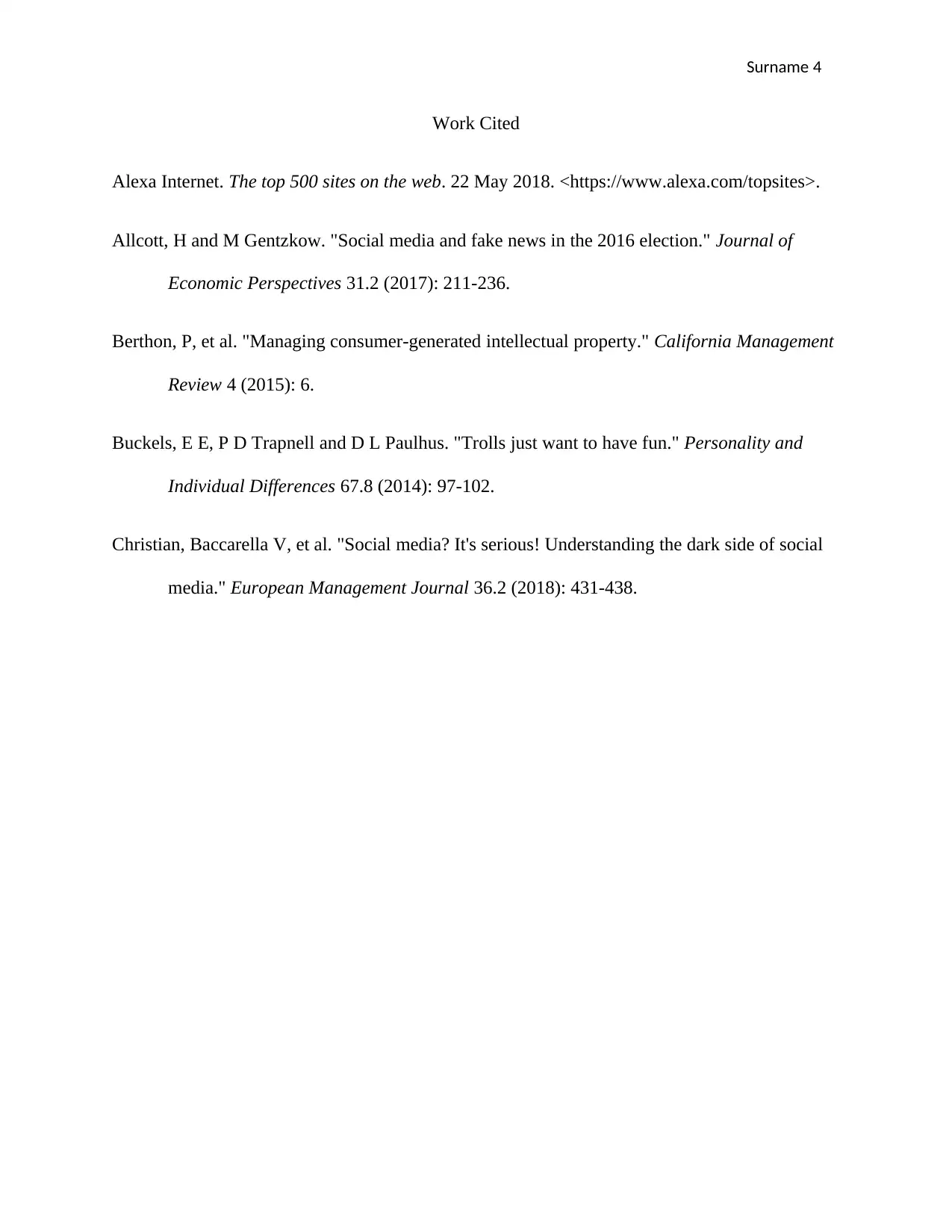Advanced Critical Writing: Social Media Dark Side Analysis Report
VerifiedAdded on 2022/10/01
|4
|1099
|21
Report
AI Summary
This report critically analyzes the article "Social media? It’s serious! Understanding the dark side of social media" by Baccarella et al. The analysis focuses on the negative aspects of social media, such as cyberbullying, fake news, privacy breaches, and addictive use, contrasting them with the commonly acknowledged benefits. The report highlights the authors' use of the seven building blocks (sharing, presence, identity, conversations, groups, reputations, and relationships) to understand how the dark side manifests. Strengths include the article's clear education on the wise use of social media and its understanding of how the building blocks are used. Weaknesses include the focus on EU citizens and the potential for continued evolution despite negative impacts. The report concludes that ethical principles and informed consent are crucial for mitigating the negative impacts of social media.

Surname 1
Student
Professor
Subject
Date
Advanced Critical Writing
The article, “Social media? It’s serious! Understanding the dark side of social media”,
was co-authored by Timm Wagner, Christian Baccarella, Jan Kietzmann, and Ian Paul
McCarthy. Previous researches and practices have concentrated on the “bright side” of social
media with an aim to understand and assist in leveraging the manifold opportunities brought by
social media (Berthon, Pitt and Kietzmann 2). Yet, it is increasingly notable that this technology
presents big risks for communities, companies, peoples, and the society at large. These big risks
are what (Christian, Timm and Jan 435) term the “dark side” of social media and include fake
news/ propaganda, addictive use, cyberbullying, online witch hunts, trolling, and privacy use. In
this assignment, I will critically analyze the negative side of social media and explain the
unwanted outcomes of this technology besides its world wide’s known incredible “bright sides”.
According to (Christian, Timm and Jan 438), social media has revolutionized the manner
in which people, society, and organizations create, share, and use information from each other.
The purpose of this article is illustrating the diverse nature of the dark sides of social media as
well as describing the undesirable outcomes of using this technology. Mainly, the study is based
on the EU younger citizens (Christian, Timm and Jan 432). The use of social media (Facebook,
Twitter, Instagram, and WhatsApp) greatly differs from traditional media use (television and
newspapers). In this article, the authors have used contemporary methodologies that suit the
Student
Professor
Subject
Date
Advanced Critical Writing
The article, “Social media? It’s serious! Understanding the dark side of social media”,
was co-authored by Timm Wagner, Christian Baccarella, Jan Kietzmann, and Ian Paul
McCarthy. Previous researches and practices have concentrated on the “bright side” of social
media with an aim to understand and assist in leveraging the manifold opportunities brought by
social media (Berthon, Pitt and Kietzmann 2). Yet, it is increasingly notable that this technology
presents big risks for communities, companies, peoples, and the society at large. These big risks
are what (Christian, Timm and Jan 435) term the “dark side” of social media and include fake
news/ propaganda, addictive use, cyberbullying, online witch hunts, trolling, and privacy use. In
this assignment, I will critically analyze the negative side of social media and explain the
unwanted outcomes of this technology besides its world wide’s known incredible “bright sides”.
According to (Christian, Timm and Jan 438), social media has revolutionized the manner
in which people, society, and organizations create, share, and use information from each other.
The purpose of this article is illustrating the diverse nature of the dark sides of social media as
well as describing the undesirable outcomes of using this technology. Mainly, the study is based
on the EU younger citizens (Christian, Timm and Jan 432). The use of social media (Facebook,
Twitter, Instagram, and WhatsApp) greatly differs from traditional media use (television and
newspapers). In this article, the authors have used contemporary methodologies that suit the
Paraphrase This Document
Need a fresh take? Get an instant paraphrase of this document with our AI Paraphraser

Surname 2
attributes of social media such as ethnography. The scholars have used social media honeycomb
frameworks to help them in explaining the dark side implications for each of the seven functional
building blocks: sharing, presence, identity, conversations, groups, reputations, and relationships.
The authors conclude that social media is used everywhere and that by analyzing the 7 building
blocks – presence, conversations, reputation, relationships, sharing, grounds, and identity
(Allcott and Gentzkow 212).
Most studies focus on the benefits of social media to organizations, individuals, and the
larger society. These studies mention the positive rewards of social media and highlight how
engagement between consumers and firms gets democratized. To companies, social media
improves public relations, customer service, personnel decision making, and product
development (Alexa Internet 2). Today, approximately 50 percent of EU companies use social
media to analyze user generated content. Interactions on social media have undoubtedly
increased (Buckels, Trapnell and Paulhus). However, no matter of the high number of
opportunities that social media create, certain incidences show that social media undoubtedly has
its ‘dark sides”. In the article, the authors point at cyberbullying, faking of news, privacy and
confidentiality invasions, trolling, addictive use, and online firestorms as the most emergent and
common demerits of social media. Also, a survey conducted in 201 revealed that Britons aged 14
to 24 years hold that social media such as Snapchat, Facebook and Instagram exacerbate self-
consciousness (Buckels, Trapnell and Paulhus 66). At least 35 percent of users of social media
encounter loss of sleep, increased anxiety levels, and depression.
The article has strengths and weaknesses. The strengths of this article rotate in the
argument that social media can have detrimental and negative effects on a society. The article
clearly educates people to use the social media wisely. The main strength is how (Christian,
attributes of social media such as ethnography. The scholars have used social media honeycomb
frameworks to help them in explaining the dark side implications for each of the seven functional
building blocks: sharing, presence, identity, conversations, groups, reputations, and relationships.
The authors conclude that social media is used everywhere and that by analyzing the 7 building
blocks – presence, conversations, reputation, relationships, sharing, grounds, and identity
(Allcott and Gentzkow 212).
Most studies focus on the benefits of social media to organizations, individuals, and the
larger society. These studies mention the positive rewards of social media and highlight how
engagement between consumers and firms gets democratized. To companies, social media
improves public relations, customer service, personnel decision making, and product
development (Alexa Internet 2). Today, approximately 50 percent of EU companies use social
media to analyze user generated content. Interactions on social media have undoubtedly
increased (Buckels, Trapnell and Paulhus). However, no matter of the high number of
opportunities that social media create, certain incidences show that social media undoubtedly has
its ‘dark sides”. In the article, the authors point at cyberbullying, faking of news, privacy and
confidentiality invasions, trolling, addictive use, and online firestorms as the most emergent and
common demerits of social media. Also, a survey conducted in 201 revealed that Britons aged 14
to 24 years hold that social media such as Snapchat, Facebook and Instagram exacerbate self-
consciousness (Buckels, Trapnell and Paulhus 66). At least 35 percent of users of social media
encounter loss of sleep, increased anxiety levels, and depression.
The article has strengths and weaknesses. The strengths of this article rotate in the
argument that social media can have detrimental and negative effects on a society. The article
clearly educates people to use the social media wisely. The main strength is how (Christian,

Surname 3
Timm and Jan 436) uses the seven building blocks to understand how communities, people, and
firms use social media in different ways. Another key strength in the article is that the
detrimental consequences of social media are unintentional. The authors state that the use of
social media is advantageous, and that people find themselves misusing or having been affected
by it while following to grab its benefits. The weak sides of this article are the notion that social
media should gradually continue to evolve despite its adverse effects on the society such as fake
news, misled adverts, and privacy invasion (Allcott and Gentzkow 234). The other weakness/
limitation of this article is its sole focus on EU citizens, the results do not consider other
countries. Last, the article persuades people to be ethical and morally right in their use of social
media, this would help curb problems such as fake news and privacy invasion.
In conclusion, social media has both advantages and disadvantages to the society,
individuals, and organizations. While most people know its merits, the demerits of social media
use have been ignored; and this is so evident in modern research. However, recent studies
indicate that social media is wrongly used for cyberbullying, spreading of fake news, abuse of
privacy, propaganda, trolling, addictive use, and online witch hunts. Therefore, companies,
people and the society at large should emphasize on using ethical principles of integrity, privacy,
and informed consent when using social media platforms.
Timm and Jan 436) uses the seven building blocks to understand how communities, people, and
firms use social media in different ways. Another key strength in the article is that the
detrimental consequences of social media are unintentional. The authors state that the use of
social media is advantageous, and that people find themselves misusing or having been affected
by it while following to grab its benefits. The weak sides of this article are the notion that social
media should gradually continue to evolve despite its adverse effects on the society such as fake
news, misled adverts, and privacy invasion (Allcott and Gentzkow 234). The other weakness/
limitation of this article is its sole focus on EU citizens, the results do not consider other
countries. Last, the article persuades people to be ethical and morally right in their use of social
media, this would help curb problems such as fake news and privacy invasion.
In conclusion, social media has both advantages and disadvantages to the society,
individuals, and organizations. While most people know its merits, the demerits of social media
use have been ignored; and this is so evident in modern research. However, recent studies
indicate that social media is wrongly used for cyberbullying, spreading of fake news, abuse of
privacy, propaganda, trolling, addictive use, and online witch hunts. Therefore, companies,
people and the society at large should emphasize on using ethical principles of integrity, privacy,
and informed consent when using social media platforms.
⊘ This is a preview!⊘
Do you want full access?
Subscribe today to unlock all pages.

Trusted by 1+ million students worldwide

Surname 4
Work Cited
Alexa Internet. The top 500 sites on the web. 22 May 2018. <https://www.alexa.com/topsites>.
Allcott, H and M Gentzkow. "Social media and fake news in the 2016 election." Journal of
Economic Perspectives 31.2 (2017): 211-236.
Berthon, P, et al. "Managing consumer-generated intellectual property." California Management
Review 4 (2015): 6.
Buckels, E E, P D Trapnell and D L Paulhus. "Trolls just want to have fun." Personality and
Individual Differences 67.8 (2014): 97-102.
Christian, Baccarella V, et al. "Social media? It's serious! Understanding the dark side of social
media." European Management Journal 36.2 (2018): 431-438.
Work Cited
Alexa Internet. The top 500 sites on the web. 22 May 2018. <https://www.alexa.com/topsites>.
Allcott, H and M Gentzkow. "Social media and fake news in the 2016 election." Journal of
Economic Perspectives 31.2 (2017): 211-236.
Berthon, P, et al. "Managing consumer-generated intellectual property." California Management
Review 4 (2015): 6.
Buckels, E E, P D Trapnell and D L Paulhus. "Trolls just want to have fun." Personality and
Individual Differences 67.8 (2014): 97-102.
Christian, Baccarella V, et al. "Social media? It's serious! Understanding the dark side of social
media." European Management Journal 36.2 (2018): 431-438.
1 out of 4
Your All-in-One AI-Powered Toolkit for Academic Success.
+13062052269
info@desklib.com
Available 24*7 on WhatsApp / Email
![[object Object]](/_next/static/media/star-bottom.7253800d.svg)
Unlock your academic potential
Copyright © 2020–2025 A2Z Services. All Rights Reserved. Developed and managed by ZUCOL.
